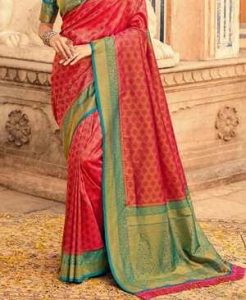Kanjivaram sarees
 Kanjivaram sarees, also known as Kanchipuram sarees, are renowned for their exquisite craftsmanship, luxurious silk fabric, and beautiful designs. The origin of Kanjivaram sarees can be traced to the town of Kanchipuram, located in the southern Indian state of Tamil Nadu. These sarees are highly prized for their exceptional craftsmanship and use of pure mulberry silk and are characterized by vibrant colors, intricate zari work, and rich patterns inspired by nature, temples, and heritage motifs.
Kanjivaram sarees, also known as Kanchipuram sarees, are renowned for their exquisite craftsmanship, luxurious silk fabric, and beautiful designs. The origin of Kanjivaram sarees can be traced to the town of Kanchipuram, located in the southern Indian state of Tamil Nadu. These sarees are highly prized for their exceptional craftsmanship and use of pure mulberry silk and are characterized by vibrant colors, intricate zari work, and rich patterns inspired by nature, temples, and heritage motifs.
Kanjivaram sarees are handwoven by skilled artisans, and the weaving process involves blending three silk threads with a fine gold thread to create a lustrous effect. Kanjivaram sarees are highly sought-after and continue to be an integral part of Indian weddings, festivals, and other special occasions.
History of Kanjivaram sarees
The history of Kanjivaram sarees is closely associated with the Chola dynasty, which ruled the region during the 4th to 13th centuries. During this period, Kanchipuram became an important center for silk weaving, patronized by the royal families and temples. The Chola kings encouraged the development of the silk industry, leading to the growth of skilled weavers and artisans in the region. Legend has it that the sage Markanda, known for his exceptional weaving skills, was the master weaver for the gods. It is believed that he passed on his weaving knowledge to the people of Kanchipuram, and thus the art of weaving Kanjivaram sarees was born.
One of the significant developments in the history of Kanjivaram sarees occurred during the Maratha rule in the late 17th century. The Maratha king Serfoji II, who ruled the princely state of Thanjavur, contributed significantly to the promotion and improvement of the silk weaving techniques in Kanchipuram. He established weaving centers and introduced new weaving patterns and designs, elevating the artistic value of Kanjivaram sarees.
During the British colonial period, the demand for Kanjivaram sarees witnessed a decline due to the import of cheaper textiles from England. However, the weavers persevered, and after India gained independence in 1947, there was a renewed interest in traditional Indian textiles, including Kanjivaram sarees.
Also read about India Sarees and Types
Manufacturing of Kanjivaram sarees
The process of making Kanjivaramsarees is intricate and involves skilled craftsmanship, where the entire production is done by hand. Each saree is a labor of love and takes several weeks to complete. Here’s a step-by-step guide on how Kanjivaramsarees are traditionally made:
1. Silk Selection: The process begins with selecting the finest silk threads for weaving the saree. The silk used in Kanjivaramsarees is of high quality and usually sourced from different parts of India, including Karnataka and Tamil Nadu.
2. Dyeing: Once the silk threads are selected, they are dyed in vibrant colors using natural or synthetic dyes. The dyed threads are then dried in the sun to set the colors.
3. Zari Preparation: Zari refers to the metallic thread used in weaving the elaborate patterns and borders of Kanjivaramsarees. Traditionally, zari was made from pure gold or silver, but nowadays, it is often a mix of copper or other metals coated with gold or silver. The zari threads are carefully wound on spools, ready to be used in the weaving process.
4. Warp Preparation: The next step is to prepare the warp, which involves arranging the silk threads vertically on the loom. The length and width of the saree are determined at this stage.
5. Weaving: The weaving process is the heart of creating a Kanjivaramsaree. It is done on traditional handlooms, where the weaver carefully interlaces the silk threads with the zari to create intricate patterns and designs. The motifs are inspired by nature, temples, and traditional elements like peacocks, flowers, checks, and paisleys.
6. Border Making: One of the distinct features of Kanjivaramsarees is their contrasting borders. The weaver separately weaves the borders using the zari threads and then attaches them to the main body of the saree.
7. Pallu Designing: The pallu, or the decorative end of the saree, is woven separately with elaborate designs and motifs. The pallu is often the most intricate part of the saree and is attached to the main body during the weaving process.
8. Joining the Parts: Once the saree body, borders, and pallu are woven separately, they are skillfully joined together to create a seamless and continuous piece of fabric.
9. Finishing Touches: After the weaving is complete, the saree undergoes several finishing processes. It is washed to remove any residual starch or dirt and to soften the fabric. The saree is then polished to enhance its shine and luster.
10. Quality Check: Each Kanjivaramsaree undergoes a rigorous quality check to ensure that it meets the high standards of craftsmanship and design associated with these sarees.
To protect the authenticity and heritage of Kanjivaram sarees, the Indian government has granted them Geographical Indication (GI) status. This recognition ensures that only sarees woven in Kanchipuram and its surrounding areas using traditional techniques can be labeled as Kanjivaram sarees, preserving the craft’s legacy for generations to come.
Also read about India Sarees and Types



